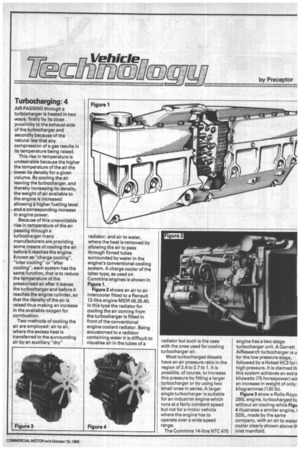Turbocharging: 4
Page 87

If you've noticed an error in this article please click here to report it so we can fix it.
AIR PASSING through a turbocharger is heated in two ways: firstly by its close proximity to the exhaust side of the turbocharger and secondly because of the natural law that any compression of a gas results in its temperature being raised. This rise in temperature is undesirable because the higher the temperature of the air the lower its density for a given volume. By cooling the air leaving the turbocharger, and thereby increasing its density, the weight of air available to the engine is increased allowing a higher fuelling level and a corresponding increase in engine power.
Because of this unavoidable rise in temperature of the air passing through a turbocharger many manufacturers are providing some means of cooling the air before it reaches the engine. Known as "charge cooling", "inter cooling" or "after cooling", each system has the same function, that is to reduce the temperature of the pressurised air after it leaves the turbocharger and before it reaches the engine cylinder, so that the density of the air is raised thus making an increase in the available oxygen for combustion.
Two methods of cooling the air are employed: air to air, where the excess heat is transferred to the surrounding air by an auxiliary "dry"
radiator; and air to water, where the heat is removed by allowing the air to pass through finned tubes surrounded by water in the engine's conventional cooling system. A charge cooler of the latter type, as used on Cummins engines is shown in Figure 1.
Figure 2 shows an air to air intercooler fitted to a Renault 12-litre engine MIDR 06.35.40. In this type the radiator for cooling the air coming from the turbocharger is fitted in front of the conventional engine coolant radiator. Being accustomed to a radiator containing water it is difficult to visualise air in the tubes of a radiator but such is the case with the ones used for cooling turbocharger air.
Most turbocharged diesels have an air pressure ratio in the region of 2.4 to 2.7 to 1. It is possible, of course, to increase this pressure by fitting a larger turbocharger or by using two small ones in series. A larger single turbocharger is suitable for an industrial engine which runs at a fairly constant speed but not for a motor vehicle where the engine has to operate over a wide speed range.
The Cummins 14-litre NTC 475 engine has a two-stage turbocharger unit. A Garrett AiResearch turbocharger is u for the low pressure stage, followed by a Holset HC3 fort high pressure. It is claimed th this system achieves an extra kilowatts (75 horsepower) wit an increase in weight of only! kilogrammes (130 lb).
Figure 3 show a Rolls-Royci 290L engine, turbocharged without air cooling while Figu 4 illustrates a similar engine, 320L, made by the same company, with an air to water cooler clearly shown above th inlet manifold.






















































































































